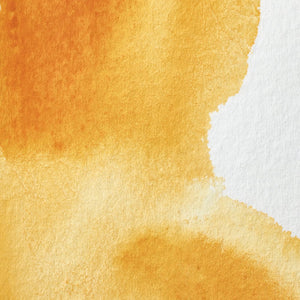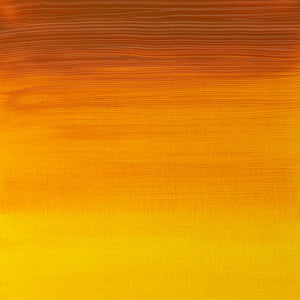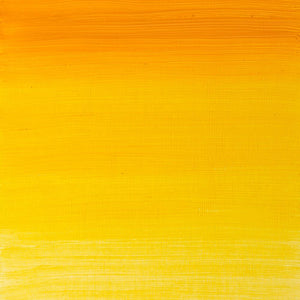
Indian Yellow is a luminous, deep-mustard pigment widely admired for its depth, body and radiance. Despite its popularity, the pigment’s peculiar source of origin remained unknown to leading artists for many years. We explore everything from Indian Yellow’s luminous discovery to its mysterious disappearance from the market and the ensuing laboratory results that would shock artists around the world.
The origins of Indian Yellow
The intriguing story of Indian Yellow begins in 15th century India. The colour was known as piuri, purree, or gogilī – the latter being an Indian form of the Persian term for ‘cow-earth’, which gives us a telling clue as to the pigment’s roots. The colour was found to have an unusual orange-yellow tone and an impressive optical luminescence that resisted fading and seemed to brighten in sunlight. It subsequently became a popular choice for painting Rajput-style miniatures and frescos, dyeing cotton cloth (calicoes) and colouring the walls of houses.

Indian Yellow's influence on the Old Masters and modern artists
Indian Yellow was employed by many of the Old Masters and later leading artists. The pigment reached Europe during the 16th and 17th centuries and was popularised by Dutch painters including Jan Vermeer, who enjoyed the brilliance and unique lightfastness of this extraordinary yellow. The colour also became part of JMW Turner’s oil and watercolour palette, seen in paintings such as The Angel Standing in the Sun (1846), and later the Scottish Colourists adopted it in oil form.
John Singer Sargent, who tended to work en plein air, found himself struggling to imitate the light from a lantern in his piece Carnation, Lily, Lily, Rose (1885-86). Eventually, he found that a combination of Indian Yellow and Mars pigments worked brilliantly in captivating the lantern’s radiant glow. One of Indian Yellow’s most famous users, however, was Van Gogh, who famously painted a luminous Indian yellow moon in his 1889 masterpiece, The Starry Night. But this was to be one of the last sightings of the colour. In the early 20th century the use of Indian Yellow was outlawed in Bengal, and the pigment disappeared from the market in mysterious circumstances.

The mysterious discovery of Indian Yellow's origins
The origins and components of Indian yellow, that had been largely unknown at the time, were gradually coming to light. For years, soft yellow lumps had been arriving unquestioned in sealed packages at the London docks from Calcutta in India – some addressed to Messrs Winsor & Newton. The dirty yellow balls would be washed and purified, and the greenish and yellow phases separated. The precise ingredients of these pieces of pigment were unidentified, but they gave off a strong odour of ammonia and were suspected of containing snake urine, ox bile or, according to a more popular theory, camel urine.
In 1883 explorer, botanist and director of Kew Gardens Sir Joseph Hooker tried to get to the bottom of the matter. He authorised an investigation into the mystery, writing a letter addressed to the Indian Department of Revenue and Agriculture to inquire into the pigment’s source. Months later, he received a reply from a T N Mukharji, an author and public servant. Mukharji described that in Mirzapur, Bengal, he had witnessed a group of cowherds (gwalas) feeding their cattle a restricted diet of mango leaves and water. The cows were malnourished and incredibly dehydrated, and this meant that their urine would turn a very bright shade of yellow. Curiously, mango leaves are known to contain the toxin urushiol, which is also found in poison ivy, and Mukharji noted that the cows ‘looked very unhealthy’. Their urine was said to have been collected and boiled into the consistency of a syrup before being strained and dried, producing a dirty yellow sediment that was then rolled and packaged off to London.

Mukharji’s study was published in the Royal Society of Arts Journal. Not long after, Indian Yellow disappeared from the market, rumoured to be as a result of animal cruelty protests that led to a law forbidding further production. Hooker subsequently had a sample of the pigment examined by the chemist Carl Gräbe.
Stranger still is what comes next. No trace of the pigment can be found stating the law or history surrounding Indian Yellow before the 1900s, except for Mukharji’s letter. There have been many investigations into the matter since. Some say the letter may have been a hoax, although this is unlikely. In 2002 writer Victoria Finlay retraced the steps of Mukharji to Mirzapur, and recounts her mission in an enlightening account that can be found in the chapter on yellow in her book Colour: Travels Through the Paintbox. Unfortunately, though, Finlay’s travels led to no evidence of the pigment. It was as recently as 2018 that success was obtained on the matter: a publication investigating the original chemical analysis by Carl Gräbe confirmed the animal origin of the sample. It identified the source as cow urine, based on a key indicator – the presence of hippuric acid.

Modern Indian Yellow: synthetic replacements and artistic applications
The original Indian Yellow was not wholly lightfast, like the modern-day synthetic replacement for Indian Yellow, which is made up of nickel azo, hansa yellow and quinacridone burnt orange. Nugget-like lumps of the original Indian yellow pigment can be found in the Winsor & Newton archive. These small finds helped our chemists in their quest to develop a colour of similar intensity in 1996. Available in our oil and watercolour ranges, the new Indian Yellow is a golden hue with excellent transparency and permanence – a staple colour in any artist’s palette and a glazing essential.












![WN PWC KAREN KLUGLEIN BOTANICAL SET [FRONT]](http://www.winsornewton.com/cdn/shop/files/136444.jpg?crop=center&v=1740654068&width=20)
![WN PWC KAREN KLUGLEIN BOTANICAL SET [OPEN 2]](http://www.winsornewton.com/cdn/shop/files/136447.jpg?crop=center&v=1740654068&width=20)
![WN PWC ESSENTIAL SET [FRONT]](http://www.winsornewton.com/cdn/shop/files/137583.jpg?crop=center&v=1740762356&width=20)
![WN PWC ESSENTIAL SET [OPEN]](http://www.winsornewton.com/cdn/shop/files/137581.jpg?crop=center&v=1740762356&width=20)
![W&N GALERIA CARDBOARD SET 10X12ML [B014096] 884955097809 [FOP]](http://www.winsornewton.com/cdn/shop/files/138855.jpg?crop=center&v=1740761853&width=20)
![W&N GALERIA CARDBOARD SET 10X12ML 884955097809 [OPEN]](http://www.winsornewton.com/cdn/shop/files/138856.jpg?crop=center&v=1740761853&width=20)

![W&N PROMARKER 24PC STUDENT DESIGNER 884955043295 [FRONT]](http://www.winsornewton.com/cdn/shop/files/78674_d4d78a69-7150-4bf4-a504-3cb5304b0f80.jpg?crop=center&v=1721326116&width=20)

![W&N PROFESSIONAL WATER COLOUR TYRIAN PURPLE [SWATCH]](http://www.winsornewton.com/cdn/shop/files/136113.jpg?crop=center&v=1724423390&width=20)
![W&N WINTON OIL COLOUR [COMPOSITE] 37ML TITANIUM WHITE 094376711653](http://www.winsornewton.com/cdn/shop/files/9238_5073745e-fcfe-4fad-aab4-d631b84e4491.jpg?crop=center&v=1721326117&width=20)
![W&N WINTON OIL COLOUR [SPLODGE] TITANIUM WHITE](http://www.winsornewton.com/cdn/shop/files/131754_19b392ee-9bf6-4caf-a2eb-0356ec1c660a.jpg?crop=center&v=1721326118&width=20)